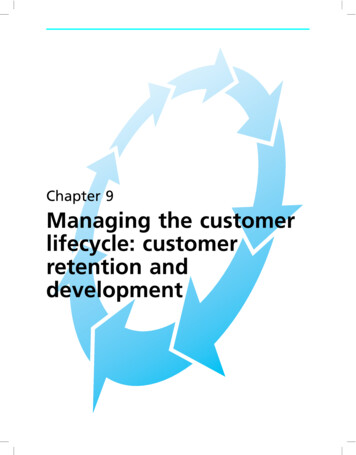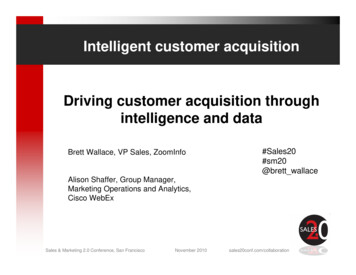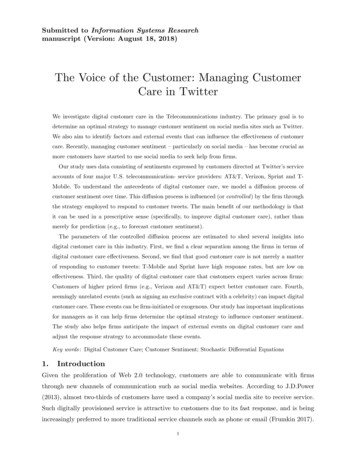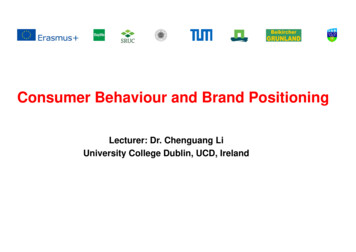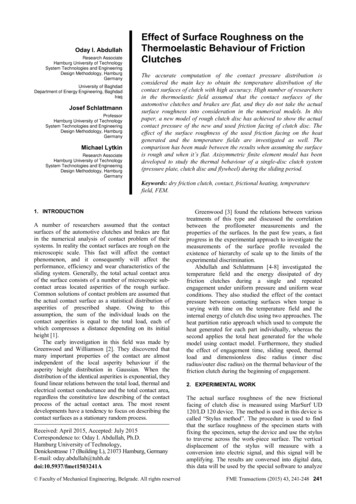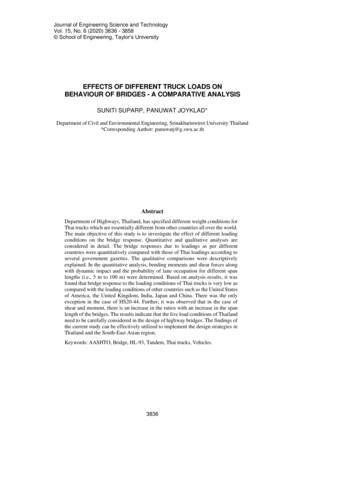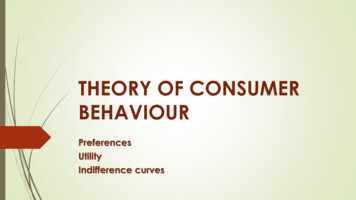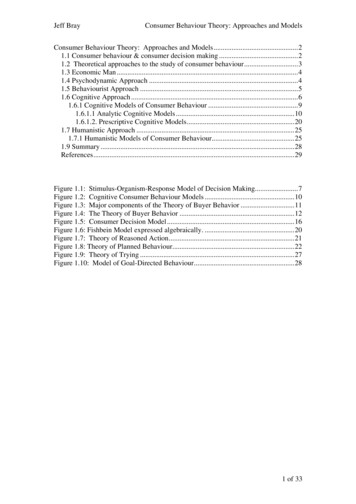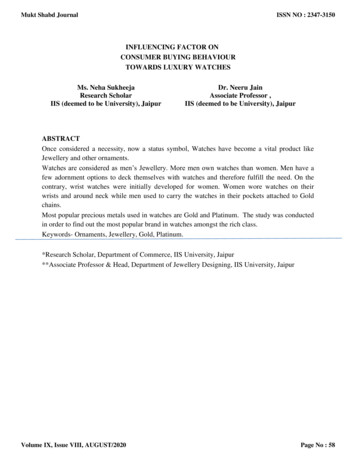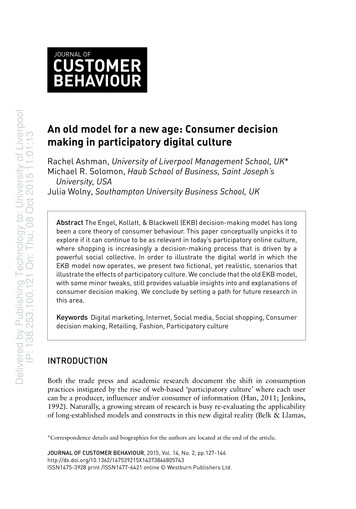
Transcription
JOURNAL OFCUSTOMERDelivered by Publishing Technology to: University of LiverpoolIP: 138.253.100.121 On: Thu, 08 Oct 2015 11:01:13BEHAVIOURAn old model for a new age: Consumer decisionmaking in participatory digital cultureRachel Ashman, University of Liverpool Management School, UK*Michael R. Solomon, Haub School of Business, Saint Joseph’sUniversity, USAJulia Wolny, Southampton University Business School, UKAbstract The Engel, Kollatt, & Blackwell (EKB) decision-making model has longbeen a core theory of consumer behaviour. This paper conceptually unpicks it toexplore if it can continue to be as relevant in today’s participatory online culture,where shopping is increasingly a decision-making process that is driven by apowerful social collective. In order to illustrate the digital world in which theEKB model now operates, we present two fictional, yet realistic, scenarios thatillustrate the effects of participatory culture. We conclude that the old EKB model,with some minor tweaks, still provides valuable insights into and explanations ofconsumer decision making. We conclude by setting a path for future research inthis area.Keywords Digital marketing, Internet, Social media, Social shopping, Consumerdecision making, Retailing, Fashion, Participatory cultureINTRODUCTIONBoth the trade press and academic research document the shift in consumptionpractices instigated by the rise of web-based ‘participatory culture’ where each usercan be a producer, influencer and/or consumer of information (Han, 2011; Jenkins,1992). Naturally, a growing stream of research is busy re-evaluating the applicabilityof long-established models and constructs in this new digital reality (Belk & Llamas,*Correspondence details and biographies for the authors are located at the end of the article.JOURNAL OF CUSTOMER BEHAVIOUR, 2015, Vol. 14, No. 2, 3846805743ISSN1475-3928 print /ISSN1477-6421 online Westburn Publishers Ltd.
Delivered by Publishing Technology to: University of LiverpoolIP: 138.253.100.121 On: Thu, 08 Oct 2015 11:01:13128JCBJournal of Customer Behaviour, Volume 142013; Capon & Hulbert, 2012). Participatory culture has low barriers to artisticexpression and civic engagement where knowledge is openly shared horizontallyamong members of digital social networks (Jenkins, 1992). This cultural shift meansthat information and power is held more firmly in the hands of the consumer, ratherthan businesses and other organisations. The emergence of a participatory culture,we believe, holds important ramifications for the shopping behaviour of consumers.In this paper we focus specifically on examining our field’s traditional perspectiveon the decision-making process. We propose some modifications to this perspectivedue to the pervasive influence of participatory culture upon contemporary consumerbehaviour.This paper aims to examine the usefulness and relevance of the EKB decisionmaking model in a contemporary marketplace where a powerful social collectivedrives individual decision making. We explore the following research question: howdoes the rise of participatory culture impact on individual decision making? Thefollowing sections discuss previous research on participatory culture with regard toconsumer decision making. We then evaluate shopping as a collective experience,before illustrating the changes that have taken place with two realistic, but fictional,vignettes. A conceptual analysis of the decision-making stages has specific ramificationsfor extant theory, and in particular the EKB model.DECISION MAKING IN PARTICIPATORY CULTURE: REVISITING THEEKB MODELThe seminal Engel, Kollatt, and Blackwell (EKB) consumer decision-making model(1968) is one of the core theories of consumer behaviour. It is based upon prior workin educational philosophy by John Dewey (1910/1978) and proposes a sequentialprocess of decision making consisting of 1) problem recognition, 2) informationsearch, 3) evaluation of alternatives, 4) purchase, and 5) post-purchase evaluation(Engel, Blackwell, & Miniard, 1995). It envisions the purchase process as a series ofdiscrete actions, typically precipitated by a conscious recognition of an unsatisfiedneed. It is grounded in a micro, utilitarian perspective (Foxall, 1989). Consequently,it conceptualises a solitary, rational decision-maker who systematically accesses andsifts through information to maximise utility (Solomon, Bamossy, Askegaard, &Hogg, 2014). It asserts that consumers go through a fixed sequence of distinct stageswhen they make purchase decisions. And while not without its critics, it appears inpractically every introductory textbook on the subject (for example Blythe, 2013;Solomon et al., 2014) and has been helpful to researchers and practitioners whorequire a basic framework that systematically defines the steps when consumersprocess information (Bloch, Sherrell, & Ridgway, 1986; Darley, Blankson, & Luethge,2010; Haubl & Trifts, 2000; Hoyer, 1984; Kim & Lee, 2008; Park & Cho, 2012).In the years that followed publication of the EKB model, some authors havequestioned the utility of this theory and it has been subject to numerous revisions,reviews and extensions (Bruner & Pomazal, 1988; Darley et al., 2010; Grewal,Roggeveen & Runyan, 2013; Howard, 1977; Howard & Sheth, 1969; Jacoby, 2002;Mowen, 1988; Olshavsky & Granbois, 1979). For instance, Olshavsky and Granbois(1979) explored the notion that a substantial proportion of our purchases do notactually involve making any decisions at all. Jacoby (2002) deemed the EKB modelto be too marketer dominated and argued that it lacked a broader recognition of
Ashman, Solomon & Wolny An old model for a new ageDelivered by Publishing Technology to: University of LiverpoolIP: 138.253.100.121 On: Thu, 08 Oct 2015 11:01:13sociocultural factors that impact upon consumer behaviour. Despite these criticisms,the EKB model is still firmly embedded as a cornerstone of consumer decisionmaking and is not likely to be jettisoned anytime soon. Yet, advances in technologyand participatory culture compel us to once again scrutinise the EKB model and itsunderlying principles, 47 years after it was first published. The next section of thispaper will describe participatory culture, and how it is impacting on decision making.PARTICIPATORY CULTUREArguably, one of the most significant changes that drives participatory culture is theability of users to integrate into networks with other like-minded individuals. Someanalysts go so far as to argue that we are on the cusp of a ‘hive minded’ mentality(Earls, 2007). The hive-mind is a large notional entity of people who share theirknowledge and opinions. This results in collective intelligence and concentric rings ofgroup affinity modulated by ritualised behaviour. For example, an emerging genre ofso-called ‘food porn’ describes the ritual we observe among people who meticulouslydocument their meals through social media sites. Through gaining this hive-likepower, consumers are more informed and cannot be easily duped by companies. Thishas given rise to a seemingly more democratic and transparent market environment.The hive-mind encourages people to work together to produce more information onproducts, which helps them to make better decisions. However, critics of the hivemind would argue that decisions about ‘what’s hot and what’s not’ may become lessindividualistic and more of a collective decision, eventually being governed by blindconsensus.Either way, this trend holds important ramifications for studies of shoppingbehaviour. In stark contrast to the sequential paradigm of the EKB model, a hivemind is constantly buzzing - and constantly acting. We propose that we are entering adecision-making environment that is ‘always on’; in concert with our digital ‘friends’,many of us engage in an on-going loop of sharing information about products,monitoring our social networks for updates, and requests for opinions and ratings onplanned and completed purchases. This leads to what can be termed polysynchronousconsumption, which we define here asintegration of two-way peer to peer, peer-content and peer-brand interaction, throughblending of multiple channels of face-to-face, asynchronous online and synchronousonline communication.Such a perspective on decision making has started to be addressed by otherresearchers in the digital marketing domain. For example, Wolny and Charoensuksai(2014) extended and enriched the decision-making model by embracing a consumercentric diary-based methodology to examine real multi-channel shopping ‘journeys’inductively. Through inductive research, an ‘orientation stage’, which is a mixture ofsignals from multiple sources and users, guides subsequent decision-making stages.Grewal et al. (2013) evaluated how social, mobile and in-store shopper marketingpractices are affecting pre-purchase, purchase and post-purchase practices. Severalquantitative studies also examine the specific impact of social influence andconformity on individual versus group opinion-seeking and decision-making inshopping contexts (Ambrus, Greiner & Pathak, 2009; Haubl & Trifts, 2000; Kang &129
130JCBJournal of Customer Behaviour, Volume 14Johnson, 2013). We build on those studies that examine the evolution of individualdecision-making processes by focusing specifically on the effect digital participatorydynamics exert upon traditional decision-making practices.Delivered by Publishing Technology to: University of LiverpoolIP: 138.253.100.121 On: Thu, 08 Oct 2015 11:01:13SHOPPING, TOGETHERAs the ways consumers interact with the bricks-and-mortar and online marketplacechange over time, so must our fundamental assumptions concerning the psychologyof consumer decision making and the sociology of consumer shopping. RobertPutnam’s (2001) controversial book Bowling alone: The collapse and revival ofAmerican community chronicled the disintegration of traditional social institutionsas people gravitate instead towards solitary pursuits such as surfing the Internet.Since the book’s publication in 2001, the Web has become more interactive and - atleast in a digital sense - most of us are far from alone. Indeed, today perhaps a moreaccurate metaphor of contemporary consumer behaviour in the online world is nolonger Bowling alone, but bowling together. Consumers avidly post their opinions,experiences, and product reviews online and eagerly seek the posts of others in theirsocial networks (Tuten & Solomon, 2012). Industry research shows that beforethey enter a store, 62% of millennial shoppers already know what they want tobuy through their research in the online environment, and 84% say that consumerwritten content on brand sites influences what they buy (Bazaarvoice, 2013).Indeed, it seems that for many young people, a meal, clothing purchase,entertainment experience, or even a romantic relationship is not ‘legitimate’ until theypost it on Facebook, Twitter, etc. This has given rise to new shopping technologiesthat maximise opportunities for sociality with known or new friends. This emergingmethod of e-commerce, which we term social shopping, allows an online shopper tostimulate and simulate the experience of shopping in a bricks-and-mortar store byaccessing feedback from other people either prior to or after deciding on a purchase.As such, social shopping is a hybrid of social networking and online retailing (Amblee& Bui, 2011; Olbrich & Holsing, 2011; Shen, 2012). As technology continues tomature, social shopping may even offer a more compelling purchase experience thanthe in-store interactions it replaces. In the process, it may transform the shoppingexperience as we currently understand it.THE RISE OF SOCIAL SHOPPINGSocial shopping mechanisms are exemplified by numerous practices such as productratings, reviews, collaborative design competitions, style advice, affiliate programs,live outfit reviews, visual scrapbooking and crowd-sourced advice. Please refer toTable 1 for a typology and examples of social shopping websites.In some instances the shopper (or perhaps his or her avatar) can actually ‘tryon’ garments and solicit feedback from a virtual mirror that enables others toview them as well. Social shopping platforms thus transform the solitary humancomputer shopping interaction into a group shopping experience that allows theonline shopper to request feedback from peers and/or experts, ‘try on’ items andperhaps even visualise them in use. Whether or not the technologies that enable socialshopping can fully replicate more traditional bricks-and-mortar experiences has yet
Ashman, Solomon & Wolny An old model for a new ageTABLE 1 Social shopping website typologyDelivered by Publishing Technology to: University of LiverpoolIP: 138.253.100.121 On: Thu, 08 Oct 2015 11:01:13Social shopping website categoriesVirtual alize.usMydecoTry it onSocialsites ocacyGotryitonASOS Fashion ASOSKloutFashionismFinderFashionThe FancyJustboughtit tGroupLinking andpurchasingnetworkingsites‘sign on’Living Social FacebookGrouponConnectBuyWithMe ModclothWaneloSource: Adapted from Ashman and Solomon (2013)to be seen. There are signs that online social networking does accelerate the paceof e-commerce. For instance, according to Griffith (2011), revenue per click fromshoppers who arrive at a site via social media links is 5.24, versus the 3.18 perclick spent by email shoppers. Academic research seems to support this amplificationeffect, insofar as there is ample empirical evidence on the ‘risky shift phenomenon’that at least in traditional environments, individuals often make riskier decisions whenthey are part of a group (e.g., Kogan & Wallach, 1967). Current research on onlinesocial shopping focuses largely upon user-generated content, social influences andrecommendations (Amblee & Bui, 201
02.03.2018 · Michael R. Solomon, Haub School of Business, Saint Joseph’s University, USA Julia Wolny, Southampton University Business School, UK Abstract The Engel, Kollatt, & Blackwell (EKB) decision-making model has long been a core theory of consumer behaviour. This paper conceptually unpicks it to explore if it can continue to be as relevant in today’s participatory online culture, where

